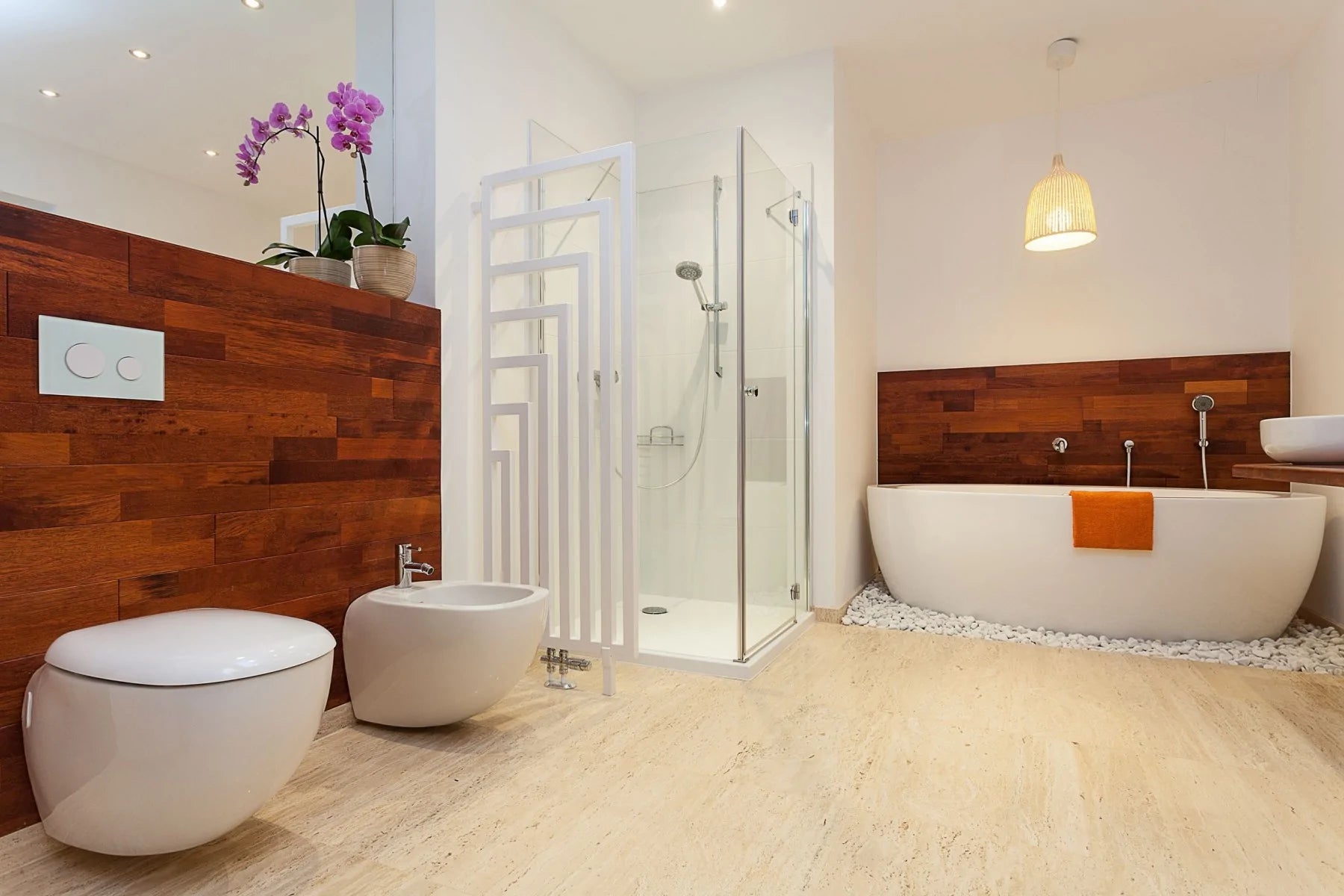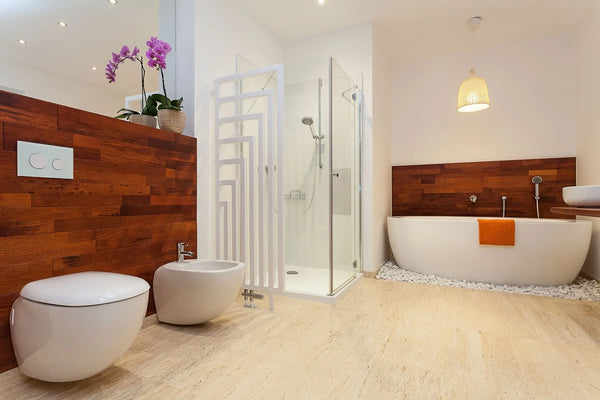Wood is a fundamental element in building, remodeling and decorating. In addition to being sturdy and reliable, wood also helps create relaxing environments that feel like home.
Many people want to incorporate wood in the bathroom, but are uncertain about how wood will fare in a wet, moist environment. As this is a valid concern, here’s how you can overcome these challenges with the right treatments, types and strategies.
Types of Wood
Most people imagine rotting, soggy planks when they think about a wood-floored bathroom. While this can certainly happen with ordinary wood materials and unfinished planks, it doesn’t with wood that’s suited for wet environments. In particular, bamboo and teak fare well in the bathroom because they’re from trees that grow in humid climates.
Bamboo
Bamboo is one of the best choices for customers seeking an affordable and eco-friendly option for wood in the bathroom. Whether you opt for bamboo floors, counters or walls, this versatile tree can be used across the bathroom in many ways. Virginia Kitchen and Bath, a remodeling company near Washington D.C., offers a few tips for how to choose and maintain bamboo in the bathroom.
Talk with the supplier about what kind of bamboo was used to manufacture the furniture or floor tiles. You’ll want something harvested from mature bamboo, as this is the most durable for withstanding the heavy wear and tear of the bathroom. When it comes to maintenance, keeping countertops dry and wiping up pools of water often can also help a bamboo surface remain intact for longer.
Customers looking for a unique approach to bamboo bathroom fixtures might also decide to create their own vanity or countertop.
HGTV and DIY Network host Matt Muenster shows how to create a bamboo bathroom countertop using just one sheet of bamboo. Muenster adds three layers of an epoxy topcoat to the counter, making sure to sand lightly in between each layer after it dries. This process is important because it helps seal the bamboo and protect it from water, making it last longer.
Using bamboo on the floor is a slightly different story. This is because bamboo is harder and much more durable than most hardwoods. This means that it withstands heavy foot traffic well, and likely won’t have to be replaced often — as long as it’s cared for properly, Joseph Lewitin at The Spruce explains.
Since bamboo flooring does have some limitations (it can’t be refinished when scratched, for example), Lewitin advises reserving it for a master or guest bathroom that will be used by adults. Family or kids bathrooms, which tend to endure more wear and tear, do better with more durable floors comprised of porcelain, marble or other bathroom tile.
To use bamboo as a decor element, consider bamboo bath mats. These can be a great alternative to cloth bath mats and fluffy textiles, Chloe Olewitz at Business Insider writes. When choosing a bamboo bath mat, something with a non-stick backing layer will eliminate the risk of slipping and sliding.
An advantage of bamboo mats is that they tend to sit lower on the floor than high-pile rugs, meaning they won’t obstruct doors opening and closing.

Teak
Teak is similar to bamboo in that it is durable and able to withstand moisture better than ordinary wood. While bamboo exudes a tropical, spa-like vibe, teak lends itself to clean, mid-century aesthetics — especially appreciated by homeowners interested in a modern bathroom design.
Teak is also more water resistant than bamboo. “Teak makes its own oil that helps resist water, mold, and weathering” explains teak retailer AquaTeak. Teak has long been used to build ships because of these properties, and its naturally-occurring oil helps make it a long-lasting investment in the bathroom.
It also means that teak can be used for bathroom sinks, interior designer Lisa Kahn writes. People tend to think of porcelain, marble and fiberglass as the go-to choice for sinks, but a teak sink can create a unique and stylish look.
One way to approach this design idea is to incorporate a sleek floating vanity made from teak, as showcased by Stephen Blake at Dwell. This particular vanity is fitted with chrome fixtures and set against a concrete wall, balancing the warmth of the wood with more modern elements.
Teak is also a sophisticated choice for storage and shelving. A simple teak shelf and towel can amp up the glam factor in an already unconventional room, Jennifer Louise Ebert at Ideal Home points out.
Faux Wood
Faux wood tiling is another way to create a wood-inspired look in the bathroom. It offers all the beauty and elegance of wood without the upkeep and maintenance, Sebring Design Build, a remodeling company based in Naperville, Illinois, says. Wood tiling also comes in a wide range of styles, colors, grains and sizes, which allows for versatility and flexibility when designing a bathroom.
Luxury vinyl tile and plank flooring also gives bathrooms a high-end look at a low price, Jennifer Lester at Floor Critics adds. Vinyl is water-resistant, waterproof and warm, so will be comfortable to walk on year-round. When opting for vinyl, be sure to choose high-quality tiles with a superior finish, which will ensure that the end result looks sleek and classy.
Wood-like tiles also come in porcelain for homeowners seeking a sturdier finish, Debbie Gartner, owner of the interior design blog The Flooring Girl, explains. Since porcelain tiles are white before the wood grain look is added, they lend themselves better to the light gray finishes popular in bathroom designs today.
Faux wood blinds are a great option for bathroom window treatments. Faux wood has a PVC coating that resists moisture, Jennifer Poindexter at The Finishing Touch writes. This means that they’d work well for covering a window nearby a freestanding or clawfoot tub, providing both natural light and privacy. Stained and painted faux wood blinds are available in extremely realistic finishes that include embossing and texture, she adds.

Wood Walls And Ceilings
Aside from using wood flooring and accessories, the material can also be used as a wall and ceiling covering.
Wood paneling can give your bathroom a rustic, timeless look, according to wood siding and paneling manufacturer The Woodworkers Shoppe. Cedar panels are the most popular choice for incorporating wood into the bathroom because they add a sophisticated look and have a light, pleasant scent. Cedar panels in the bathroom should be finished with crown molding and trim, as this helps give the entire room a more polished look.
If you’re remodeling an older home that already has wood paneling on the walls, there are a few ways to update the space. One is to whitewash the walls with a light-colored paint, Stephanie Booth at Realtor.com writes. With a technique that involves watering down paint, wiping it and letting it dry, the wood is given a fresh finish that feels timeless. This technique also helps preserve the natural textures and grooves of the wood so that it doesn’t lose its character.
Beth Hunter, owner of the popular DIY blog Home Stories A to Z, provides a beautiful example of how wood planks can work on a bathroom ceiling. This bathroom is complete with elegant white and gray tiles, a large window frame mirror and a dazzling chandelier. Yet, the wood on the ceiling helps keep the space feeling grounded and approachable for everyday use. Other touches, like the wrought-iron frame around the mirror and the woven basket and lush plant, help tie in the wood ceiling and balance the other elegant elements of the space.
Images by: bialasiewicz/©123RF Stock Photo, tiwaz/©123RF Stock Photo, João Jesus







